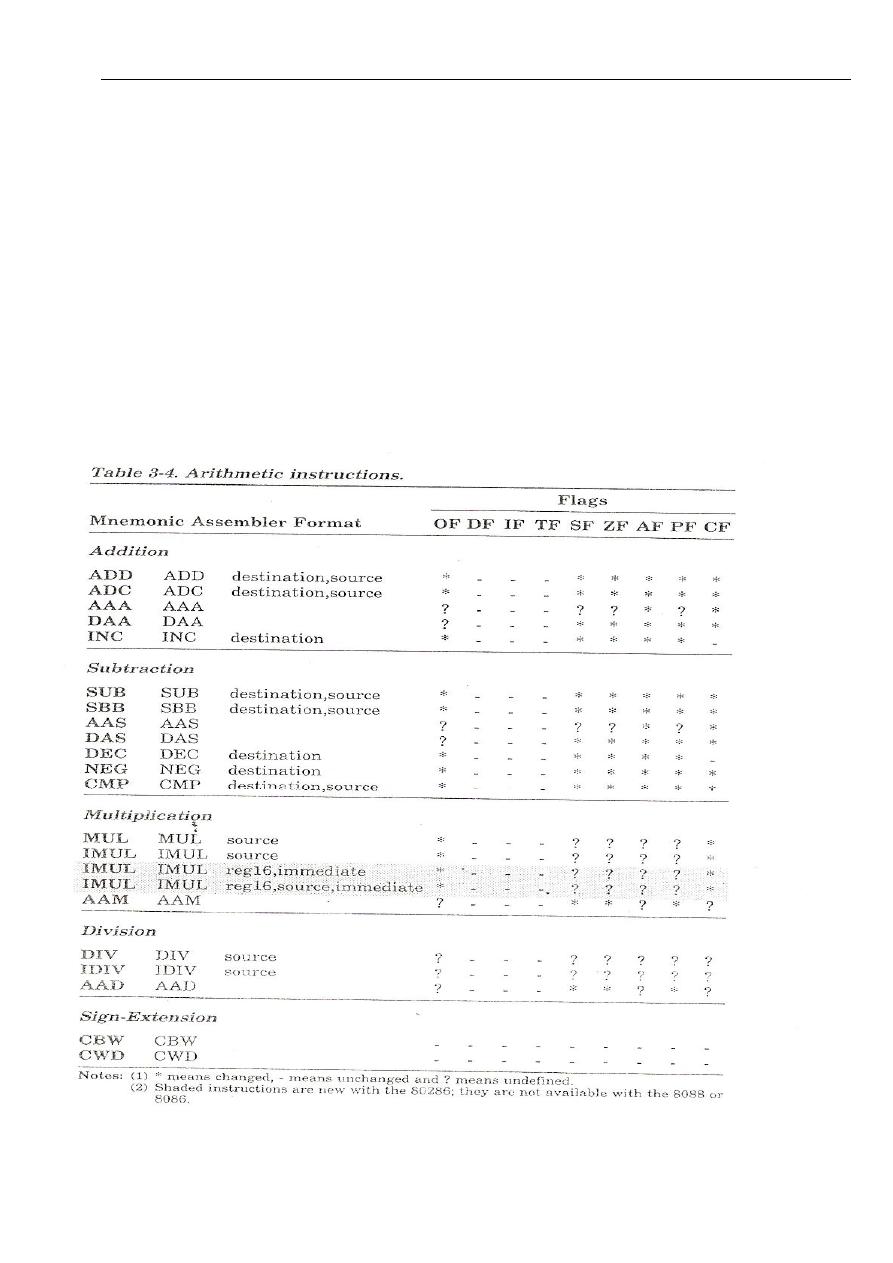
ﺤﺎﺴﺒﺎﺕ ﻤﺘﻘﺩﻤﺔ ﺍﻟﻤﺭﺤﻠﺔ ﺍﻟﺜﺎﻟﺜﺔ ﻫﻨﺩﺴﺔ ﻜﻬﺭﻭ ﻤﻴﻜﺎﻨﻴﻙ ﺍﻟﻤﺩﺭﺱ ﻤﺴﺎﻋﺩ ﺍﻨﻤﺎﺭ ﺨﻠﻴل ﺍﺒﺭﺍﻫﻴﻡ
٨٤
ARITHMETIC INSTRUCTIONS
The 8086 can perform arithmetic operations on binary numbers (signed or
unsigned) and on decimal numbers (packed or unpacked). As Table 1 shows,
there
are
instructions
for
the
four
standard
arithmetic
functions-addition,
subtraction, multiplication, and division. There are also instructions that "sign-
extend" operands; these let you combine data of different sizes (e.g., add a byte
to a word).
ﺔ!!!ﯿﺋﺎﻨﺜﻟا مﺎ!!!ﻗرﻻا ﻰ!!!ﻠﻋ تﺎ!!!ﯿﻠﻤﻌﺑ مﻮ!!!ﻘﯾ نا ﺞﻟﺎ!!!ﻌﻤﻠﻟ ﻦ!!!ﻜﻤﯾ
)
ﺎرة!!!ﺷا نوﺪ!!!ﺑ ﻢ!!!ﻗر ، ﺎرة!!!ﺷﺎﺑ ﻢ!!!ﻗر
(
ﺮﯾﺔ!!!ﺸﻌﻟا مﺎ!!!ﻗرﻻاو
(packed or unpacked)
.
!!!ﺬﻟﻚ اﻻﯾﻌ!!!ﻛو ﺔ!!!ﻌﺑرﻻا تﺎ!!!ﯿﻠﻤﻌﻟا لوﺪ!!!ﺠﻟا ﻦﯿ!!!ﺒﯾو
ﺎ
ﺬا!!!ھو ةرﺎ!!!ﺷﻻا ﻊ!!!ﺳﻮﯾ يﺬ!!!ﻟا تاز
ﯾﺴﻤﺢ ﺑﻀﻢ ﺑﯿﺎﻧﺎت ﺑﺎﺣﺠﺎم ﻣﺨﺘﻠﻔﺔ
.

ﺤﺎﺴﺒﺎﺕ ﻤﺘﻘﺩﻤﺔ ﺍﻟﻤﺭﺤﻠﺔ ﺍﻟﺜﺎﻟﺜﺔ ﻫﻨﺩﺴﺔ ﻜﻬﺭﻭ ﻤﻴﻜﺎﻨﻴﻙ ﺍﻟﻤﺩﺭﺱ ﻤﺴﺎﻋﺩ ﺍﻨﻤﺎﺭ ﺨﻠﻴل ﺍﺒﺭﺍﻫﻴﻡ
٩٤
1-Addition Instructions
1. Add (ADD) and Add With Carry (ADC)
The ADD and ADC instructions can add 8- or 16-bit operands. ADD adds a source and
destination operand and puts the result in the destination. Symbolically, we can represent
this as
ﯾﻤﻜﻦ ﻻﯾﻌﺎزي
ADD and ADC
ان ﺗﺠﻤﻊ ﻣﻌﻠﻮﻣﺎت ﺑ
ﻄﻮل
8 or 16 bit
وﯾﺘﻢ اﺿﺎﻓﺔ اﻟﻤﺼﺪر اﻟﻰ اﻟﻤﺴﺘﻘﺮ وﯾﺨﺰن
اﻟﻨﺎﺗ
ﺞ ﻓﻲ اﻟﻤﺴﺘﻘﺮ
destination = destination + source
ADC does the same thing as ADD, except it includes the Carry Flag (CF) in the addition,
like this:
وﯾﺸﺎﺑﮫ اﯾﻌﺎز
ADC
اﯾﻌﺎز
ADD
ﺑﺎﺳﺘﺜﻨﺎء اﻧﮫ ﯾﺠﻤﻊ اﯾﻀﺎ
ﻗﯿﻤﺔ
Carry Flag (CF)
destination = destination + source + carry
Now you can see why the 8086 has two separate add instructions. One
instruction, ADD, can add single-byte or single-word numbers and the low-order
terms of 32-bits numbers. The other, ADC, is used to add the higher-order terms
of two 32-bits numbers.
واﻻن ﻧﺴﺘﻄﯿﻊ ان اﻟﻤﻌﺎﻟﺞ
ﻟﮫ اﯾﻌﺎزي ﺟﻤﻊ ﻣﻨﻔﺼﻠﯿﻦ ﻋﻦ ﺑﻌﻀﮭﺎ اﻟﺒﻌﺾ
.
اﻻول ھﻮ اﯾﻌﺎز
ADD
واﻟﺬي ﺑﺎﻣﻜﺎﻧﮫ ان
ﯾﺠﻤﻊ ﺑﺎﯾﺖ واﺣﺪ او ﻛﻠﻤﺔ واﺣﺪة او اﻟﺠﺰء اﻻدﻧﻰ ﻣﻦ اﻟﺮﻗﻢ
32-bits
وﯾﺴﺘﺨﺪم اﯾﻌﺎز
ADC
ﻟﺠﻤﻊ اﻟﺠﺰء اﻻ
ﻋﻠﻰ ﻣﻦ
اﻟﺮﻗﻢ
32-bits
.
For example:
ADD AX , CX
adds the 16-bit contents of AX and CX and returns the result in AX. If your operands are
longer than 16 bits, you can use this kind of sequence:
اﻻﯾﻌﺎز اﻟﺴﺎﺑﻖ ﯾﺠﻤﻊ ﻣﺤﺘﻮى
16 bit
ﻟﻤﺴﺠﻠﻲ
AX and CX
واﻟﻨﺎﺗﺞ ﯾ
ﺨﺰن ﻓﻲ ﻣﺴﺠﻞ
AX
.
واذاﻛﺎن ﻃﻮل اﻟﺮﻗﻤﯿﻦ
اﻃﻮل ﻣﻦ
16-bit
ﻓﺎﻧﻨﺎ ﻧﺴﺘﺨﺪم ھﺬا اﻟﻨﻮع ﻣﻦ ﺗﺴﻠﺴﻞ اﻻﯾﻌﺎزات

ﺤﺎﺴﺒﺎﺕ ﻤﺘﻘﺩﻤﺔ ﺍﻟﻤﺭﺤﻠﺔ ﺍﻟﺜﺎﻟﺜﺔ ﻫﻨﺩﺴﺔ ﻜﻬﺭﻭ ﻤﻴﻜﺎﻨﻴﻙ ﺍﻟﻤﺩﺭﺱ ﻤﺴﺎﻋﺩ ﺍﻨﻤﺎﺭ ﺨﻠﻴل ﺍﺒﺭﺍﻫﻴﻡ
٠٥
ADD AX,CX ;Add low – order 16 bits,
ADD BX,DX ;then high – order 16 bits,
which adds the 32-bit number in CX and DX to the one in AX and BX. Here, the ADC
instruction includes any carry out of (CX) + (AX) into (DX)+ (BX).
وﺗﺴﻠﺴﻞ اﻻﯾﻌﺎزات ﯾﻘﻮم ﺑﺠﻤﻊ رﻗﻤﯿﻦ ﺑﻄﻮل
32-bit
ﺣﯿﺚ ﯾﻜﻮن
اﻟﺮﻗﻢ
اﻻول ﻓﻲ اﻟﻤﺴﺠﻠﯿﻦ
CX and DX
واﻟﺮﻗﻢ
اﻟﺜﺎﻧﻲ ﻓﻲ اﻟﻤﺴﺠﻠﯿﻦ
AX and BX
وﯾﻘﻮم اﻻﯾﻌﺎز
ADC
ﺑﺎﺧﺬ ﺑﻨﻈﺮ اﻻﻋﺘﺒﺎر
carry out
ان ﺣﺪث ﻣﻦ ﻋﻤﻠﯿﺔ ا
ﻟﺠﻤﻊ
ﺑﯿﻦ اﻟﻤﺴﺠﻠﯿﻦ
(DX)+ (BX)
اﻟﻰ ﻋﻤﻠﯿﺔ اﻟﺠﻤﻊ ﺑﯿﻦ اﻟﻤﺴﺠﻠﯿﻦ
(CX) + (AX)
.
You may also add a memory operand to a general register (or vice versa) or add an
immediate value to a register or to memory. Some examples are:
وﯾﻤﻜﻦ ان ﯾﺠﻤﻊ ﻣﻮﻗﻊ ذاﻛﺮة ﻣﻊ ﻣﺴﺠﻞ ﻋﺎم و
اﻟﻌﻜﺲ ﺑﺎﻟﻌﻜﺲ او اﺿﺎﻓﺔ اﻟﻘﯿﻤﺔ اﻟﻤﺒﺎﺷﺮة اﻟﻰ ﻣﺴﺠﻞ او ﻣﻮﻗﻊ اﻟﺬاﻛﺮة وھﺬه
ﺑﻌﺾ اﻻﻣﺜﻠﺔ ﻋﻠﻰ ھﺬا اﻟﻤﻮﺿﻮع
ADD AX , MEM_WORD; Add a memory operand to a register
ADD MEM_WORD , AX ; or vice versa
ADD AL , 10 ; Add a constant to a register
ADD MEM_BYTE , 0FH ; or to a memory location
Note that most combinations are legal, but you may not add memory-to memory, nor may
you use an immediate value as a destination.
وﯾﺠﺐ ان ﻧﻼﺣﻆ اﻧﮫ ﻻﯾﻤﻜﻦ ان ﻧﺠﻤﻊ ﻣﻮﻗﻌﯿﻦ ذاﻛﺮة ﻣﺒﺎﺷﺮة او اﺳﺘﺨﺪام اﻟﻘﯿﻤﺔ اﻟﻤﺒﺎﺷﺮة ﻛﻤﺴﺘﻘﺮ
.
2.(AAA and DAA) Instructions Adjust for Addition
The 8086 always adds numbers as if they were binary. What happens if they are
binary-coded decimal (BCD) numbers? Let's find out by looking at an examples.
ان ﻣﻌﺎﻟﺞ
8086
ﯾﻘﻮم ﺑﺠﻤﻊ اﻻرﻗﺎم ﻛﺎرﻗﺎم ﺛﻨﺎﺋﯿﺔ وﻟﻜﻦ
اذا ﻛﺎن اﻻرﻗﺎ
م ﻣﻦ ﻧﻮﻋﯿﺔ
BCD
ﻓﻜﯿﻒ ﯾﺘﻢ اﻟﺘﻌﺎﻣﻞ ﻣﻊ ھﺬا
اﻟﻤﻮﺿﻮع ﻓﻠﻨﺮى ﺑﻌﺾ اﻻﻣﺜﻠﺔ
.
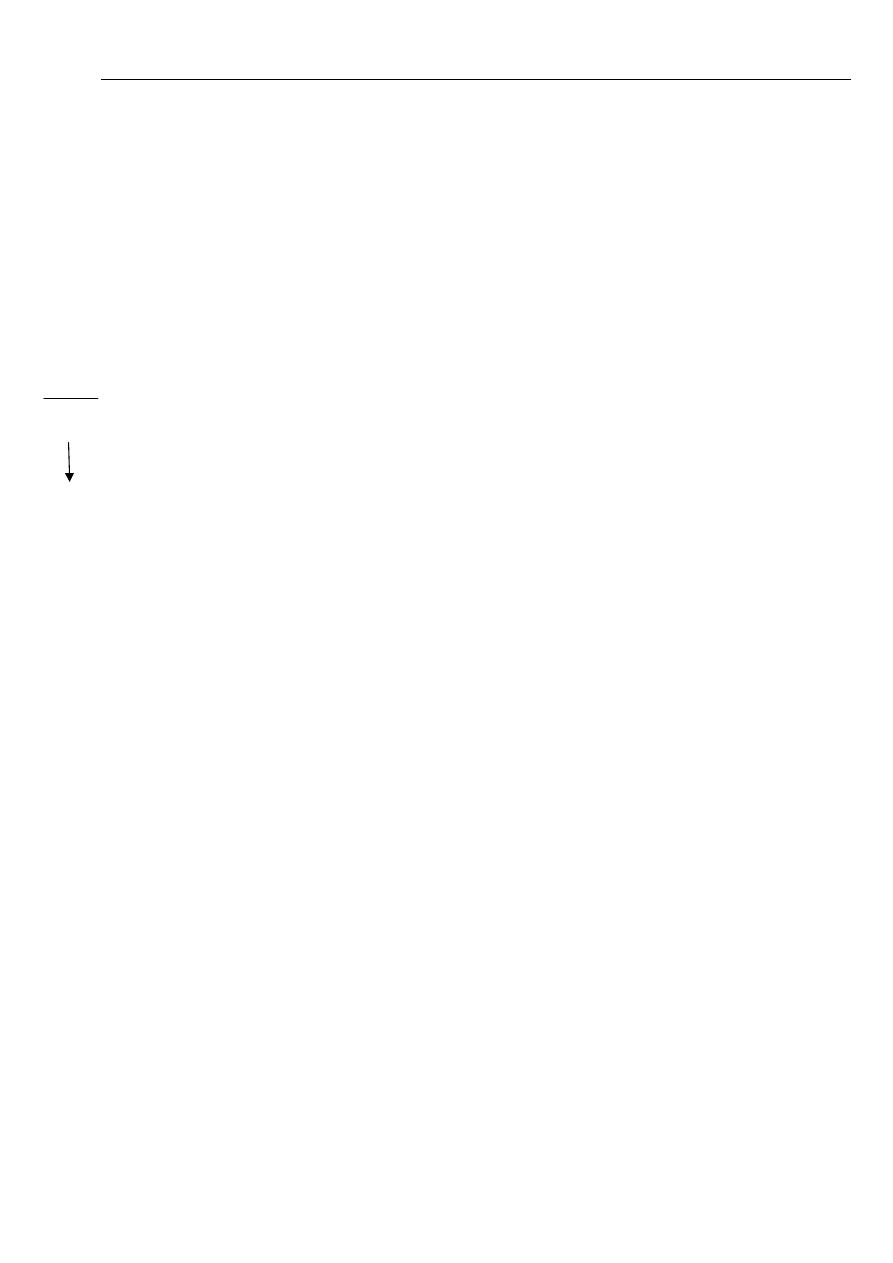
ﺤﺎﺴﺒﺎﺕ ﻤﺘﻘﺩﻤﺔ ﺍﻟﻤﺭﺤﻠﺔ ﺍﻟﺜﺎﻟﺜﺔ ﻫﻨﺩﺴﺔ ﻜﻬﺭﻭ ﻤﻴﻜﺎﻨﻴﻙ ﺍﻟﻤﺩﺭﺱ ﻤﺴﺎﻋﺩ ﺍﻨﻤﺎﺭ ﺨﻠﻴل ﺍﺒﺭﺍﻫﻴﻡ
١٥
1. Unpacked BCD number and AAA Instruction
If you add the unpacked BCD numbers 26 and 42, the 8086 performs this Hexadecimal
addition:
اذا ﺗﻢ اﺿﺎﻓﺔ رﻗﻤﯿﻦ
unpacked BCD
ھﻤﺎ
26 and 42
ﻓﺎن اﻟﻤ
ﻌﺎﻟﺞ ﺳﯿﻘﻮم ﺑﺎﺟﺮاء ﻋﻤﻠﯿﺔ اﻟﺠﻤﻊ ﺑﺎﻟﻨﻈﺎم اﻟﺴﺎدس
ﻋﺸﺮي وﻛﺎﻻﺗﻲ
26
42 +
68 hexadecimal
08 BCD
If we use an AAA instruction after the addition operation will clear the 4 bit in the left
of register AL and leave the 4 bit in the right of AL and have no effect on AH and no
effect on flags because the Low digit is less the number 9.
اذا ﺗﻢ اﺳﺘﺨﺪام اﯾﻌﺎز
AAA
ﻟﺘﺤﻮﯾﻞ ﻧﺎﺗﺞ اﻟﺠﻤﻊ ﻣﻦ اﻟﻨﻈﺎم اﻟﺴﺎدس اﻟﻌﺸﺮي اﻟﻰ ﻧﻈﺎم
BCD
ﻓﺎن اﯾﻌﺎز
AAA
ﯾﻘﻮم ﺑﺘﺼﻔﯿﺮ اﻻرﺑﻌﺔ اﻟﻰ اﻟﯿﺴﺎر
High DIGIT
ﻣﻦ اﻟﻤﺴﺠﻞ
AL
وﯾﺘﺮك اﻻرﺑﻌﺔ اﻟﻰ اﻟ
ﯿﻤﯿﻦ
LOW DIGIT
ﺑﺪون ﺗﻐﯿﯿﺮ وﻟﯿﺲ ھﻨﺎك ﺗﺎﺛﯿﺮ ﻋﻠﻰ
AH
وﻻ ﻋﻠﻰ
FLAGS
ﻻن اﻟﺮﻗﻢ اﻟﻨﺎﺗﺞ ﻓﻲ
LOW DIGIT
اﻗﻞ ﻣﻦ اﻟﺘﺴﻌﺔ
.
This instruction is deal with only 4 bit in the right of AL and only it deal with AL
register if the 4 bit in the right is exceed number 9 it add six to correct this digit and
clear the digit in the left and add 1 to the AH and set 1 to AF and CF and check the
value of PF and SF.
وھﺬا ﯾﻌﻨﻲ ان اﻻﯾﻌﺎز ﻓﻘﻂ ﯾﺘﻌﺎﻣﻞ ﻣﻊ اﻻرﺑﻌﺔ ﺑﺘﺎت ﻓﻲ اﻟﯿﻤﯿﻦ ﻣﻦ اﻟﻤﺴﺠﻞ
AL
وﻓﻘﻂ اﻟﻤﺴﺠﻞ
AL
وﻋﻨﺪﻣﺎ ﯾﺘﺠﺎوز
اﻟﻨﺎﺗﺞ ﻓﻲ
LOW DIGIT
اﻟ
ﺮﻗﻢ
9
ﻓﺎﻧﮫ ﯾﺼﺤﺢ ﺑﺎﺿﺎﻓﺔ
6
اﻟﻰ اﻟﺮﻗﻢ وﯾﻘﻮم ﺑﺘﺼﻔﯿﺮ
High Digit
اﻟﻰ اﻟﯿﺴﺎر وﻛﺬﻟﻚ
ﯾﻀﯿﻒ واﺣﺪ اﻟﻰ اﻟﻤﺴﺠﻞ
AH
وﻧﺠﻌﻞ ﻗﯿﻢ ال
flag
ﻛﺎﻻﺗﻲ
AF=1
و
CF=1
وﻧﺪﻗﻖ ﻗﯿﻤﺘﻲ
PF and SF
.
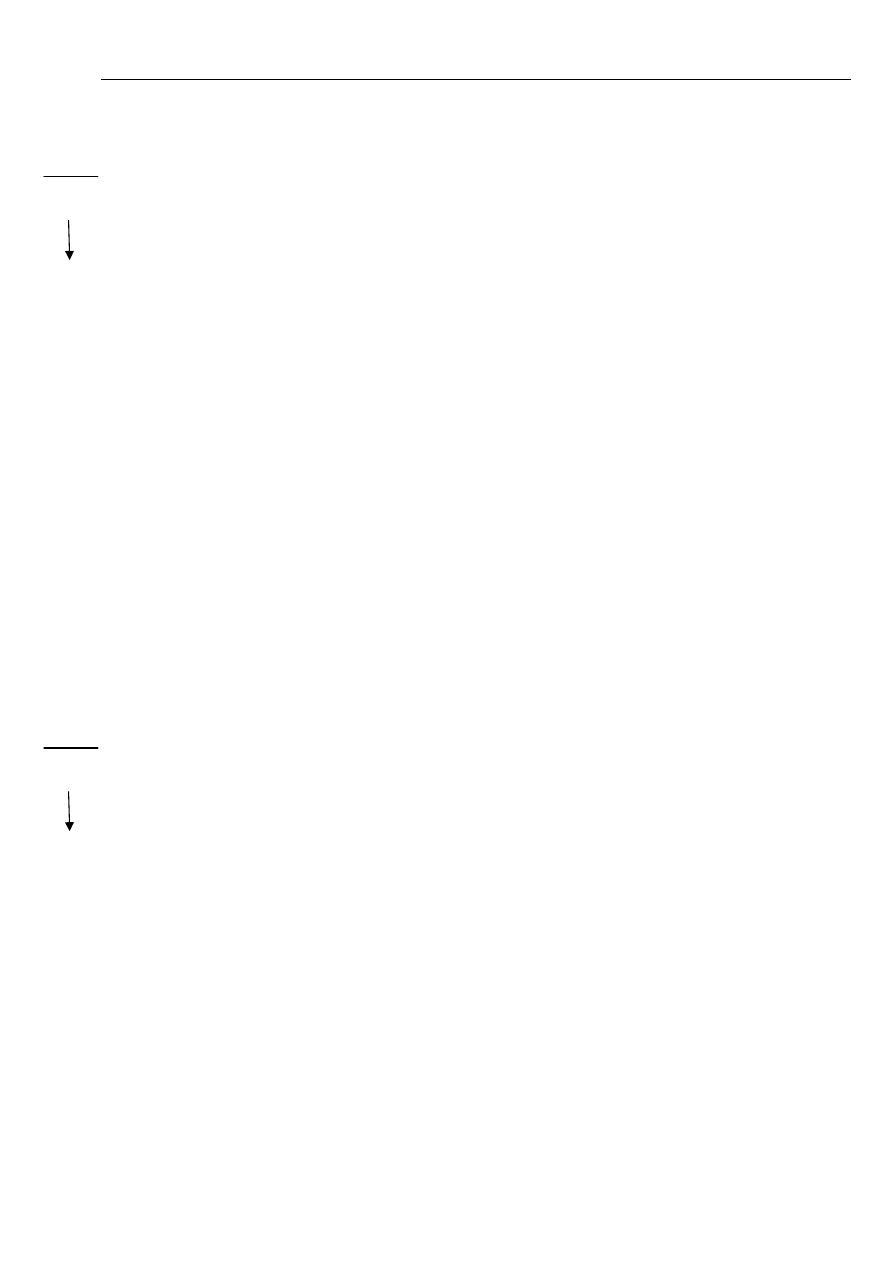
ﺤﺎﺴﺒﺎﺕ ﻤﺘﻘﺩﻤﺔ ﺍﻟﻤﺭﺤﻠﺔ ﺍﻟﺜﺎﻟﺜﺔ ﻫﻨﺩﺴﺔ ﻜﻬﺭﻭ ﻤﻴﻜﺎﻨﻴﻙ ﺍﻟﻤﺩﺭﺱ ﻤﺴﺎﻋﺩ ﺍﻨﻤﺎﺭ ﺨﻠﻴل ﺍﺒﺭﺍﻫﻴﻡ
٢٥
26
48 +
6E
04
وﯾﻀﯿﻒ
1
اﻟﻰ ﻗﯿﻤﺔ ﻣﺴﺠﻞ
AH
وﺗﻜﻮن ﻗﯿﻢ
Flags
ﻛﺎﻻﺗﻲ
AF=1, CF=1, PF=0,SF=0
2. Packed BCD number and DAA Instruction
If you add the packed BCD numbers 46 and 43, the 8086 performs this Hexadecimal
addition:
اذا ﺗﻢ اﺿﺎﻓﺔ رﻗﻤﯿﻦ
packed BCD
ھﻤﺎ
46 and 43
ﻓﺎن اﻟﻤﻌﺎﻟﺞ ﺳﯿﻘﻮم ﺑﺎﺟﺮاء ﻋﻤﻠﯿﺔ اﻟﺠﻤﻊ ﺑﺎﻟﻨﻈﺎم اﻟﺴﺎدس
ﻋﺸﺮي وﻛﺎﻻﺗﻲ
46
43 +
89 hexadecimal
89 BCD
If we use an DAA instruction after the addition operation will have no effect on the
two digits in the register AL and have no effect on AH and no effect on flags because
the Low digit and High digit is less the number 9.
اذا ﺗﻢ اﺳﺘ
ﺨﺪام اﯾﻌﺎز
DAA
ﻟﺘﺤﻮﯾﻞ ﻧﺎﺗﺞ اﻟﺠﻤﻊ ﻣﻦ اﻟﻨﻈﺎم اﻟﺴﺎدس اﻟﻌﺸﺮي اﻟﻰ ﻧﻈﺎم
BCD
ﻓﺎن اﯾﻌﺎز
DAA
ﻟﻦ
ﯾﻜﻮن ﻟﮫ ﺗﺎﺛﯿﺮ ﻋﻠﻰ اﻟﺮﻗﻤﯿﻦ ﻓﻲ ﻣﺴﺠﻞ
AL
وﻻ ﻋﻠﻰ اﻟﻤﺴﺠﻞ
AH
وﻻ ﻋﻠﻰ
Flags
وذﻟﻚ ﻻﻧﮫ ﻛﻞ ﻣﻦ اﻟﺮﻗﻤﯿﻦ
Low digit and High digit
ھﻤﺎ اﻗﻞ ﻣﻦ ﺗﺴﻌﺔ
.
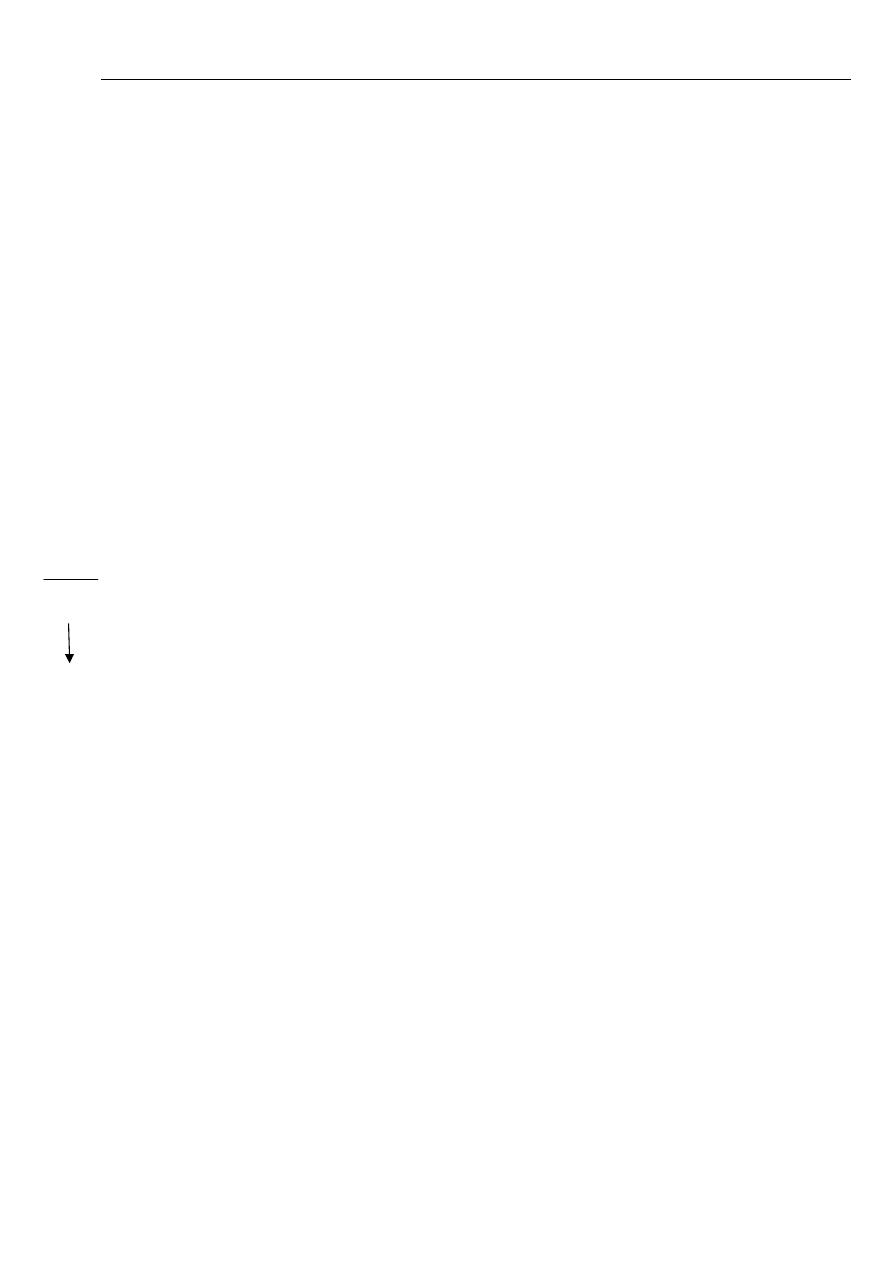
ﺤﺎﺴﺒﺎﺕ ﻤﺘﻘﺩﻤﺔ ﺍﻟﻤﺭﺤﻠﺔ ﺍﻟﺜﺎﻟﺜﺔ ﻫﻨﺩﺴﺔ ﻜﻬﺭﻭ ﻤﻴﻜﺎﻨﻴﻙ ﺍﻟﻤﺩﺭﺱ ﻤﺴﺎﻋﺩ ﺍﻨﻤﺎﺭ ﺨﻠﻴل ﺍﺒﺭﺍﻫﻴﻡ
٣٥
This DAA instruction is deal with two digits the register AL and only it deal with AL
register if the 4 bit in the right (low digit) exceed number 9 or if the 4 bit in the left
(High digit) exceed number 9 or both exceed number 9 it will add six to correct the digit
which will exceed number 9 and have no effect on the AH and set 1 to AF and CF and
check the value of PF and SF.
وھﺬا ﯾﻌﻨﻲ ان اﻻﯾﻌﺎز
DAA
ﯾﺘﻌﺎﻣﻞ ﻣﻊ
اﻟﺮﻗﻤﯿﻦ ﻓﻲ
اﻟﻤﺴﺠﻞ
AL
وﻋﻨﺪﻣﺎ ﯾﺘﺠﺎوز اﻟﻨﺎﺗﺞ ﻓﻲ
LOW DIGIT
اﻟﺮﻗﻢ
9
اوﻋﻨﺪﻣﺎ ﯾﺘﺠﺎوز اﻟﻨﺎﺗﺞ ﻓﻲ
High DIGIT
اﻟﺮﻗﻢ
9
اوﻋﻨﺪﻣﺎ ﯾﺘﺠﺎوز اﻟﻨﺎﺗﺞ ﻓﻲ اﻟﺮﻗﻤﯿﻦ اﻟﺮﻗﻢ
9
ﻓﺎﻧﮫ ﯾﺼﺤﺢ
ﺑﺎﺿﺎﻓﺔ
6
اﻟﻰ اﻟﺮﻗﻢ
اﻟﺬي ﺗﺠﺎوز اﻟﺮﻗﻢ ﺗﺴﻌﺔ وﻟﯿﺲ ﻟﮫ ﺗﺎﺛﯿﺮ ﻋﻠﻰ
اﻟﻤ
ﺴﺠﻞ
AH
وﻧﺠﻌﻞ ﻗﯿﻢ ال
flag
ﻛﺎﻻﺗﻲ
AF=1
و
CF=1
وﻧﺪﻗﻖ ﻗﯿﻤﺘﻲ
PF and SF
.
46
89 +
CF
35
و
ﻻﯾﺆﺛﺮ ﻋﻠﻰ
ﻗﯿﻤﺔ ﻣﺴﺠﻞ
AH
وﺗﻜﻮن ﻗﯿﻢ
Flags
ﻛﺎﻻﺗﻲ
AF=1, CF=1, PF=1,SF=0
3. Increment Destination by One (INC)
The INC instruction adds 1 to a register or memory operand but, unlike ADD,
does not affect the Carry Flag (CF). INC is convenient for increasing loop
counters .It can also be used to increase an index register or pointer when you
are accessing consecutive locations in memory. Examples are:
ان اﯾﻌﺎز
INC
ﯾﻀﯿﻒ واﺣﺪ
اﻟﻰ ﻣﺤﺘﻮى ﻣﺴﺠﻞ او ﻣﻮﻗﻊ اﻟﺬاﻛﺮة وﻟﻜﻨﮫ ﻟﯿﺲ ﻣﺜﻞ اﯾﻌﺎز
ADD
ﻓﺎﻧﮫ ﻻﯾﺆﺛﺮ ﻋﻠﻰ
CF
.
وھﻮ ﯾﺴﺘﺨﺪم ﻓﻲ زﯾﺎدة ﻋﺪادات اﻟﺤﻠﻘﺎت اﻟﺘﻜﺮارﯾﺔ وﯾﻤﻜﻦ ان ﯾﺰﯾﺪ ﻗﯿﻤﺔ ﻣﺴﺠﻞ ﻓﮭﺮﺳﺔ او ﻣﺆﺷﺮ وذﻟﻚ ﻋﻨﺪ ﻣﻌﺎﻟﺠﺔ ﻣﻮاﻗﻊ
ﻣﺘﺴﻠﺴﻠﺔ ﻓﻲ اﻟﺬاﻛﺮة واﻻﻣﺜﻠﺔ ﻟﻠﻤﻮﺿﻮع ھﻲ

ﺤﺎﺴﺒﺎﺕ ﻤﺘﻘﺩﻤﺔ ﺍﻟﻤﺭﺤﻠﺔ ﺍﻟﺜﺎﻟﺜﺔ ﻫﻨﺩﺴﺔ ﻜﻬﺭﻭ ﻤﻴﻜﺎﻨﻴﻙ ﺍﻟﻤﺩﺭﺱ ﻤﺴﺎﻋﺩ ﺍﻨﻤﺎﺭ ﺨﻠﻴل ﺍﺒﺭﺍﻫﻴﻡ
٤٥
INC CX ;Increment a word register
INC AL ;Increment a byte register
INC MEM_BYTE ; Increment a byte in memory
INC MEM_WORD ; Increment a word in memory
2-Subtraction Instructions
1. How the Microprocessor Subtracts
Like every other general-purpose microprocessor, the 8086, has no internal subtraction
unit. However, it does have an addition unit an adder and can subtract numbers by adding
them.
ﻣﺜﻞ ﻛﻞ اﻟﻤﻌﺎﻟﺠﺎت ذات اﻻﺳﺘﺨﺪام اﻟﻌﺎم ﻓﺎن اﻟﻤﻌﺎﻟﺞ
8086
ﻻﯾﻤﺘﻠﻚ وﺣﺪة ﻃﺮح داﺧﻠﯿﺔ ﺑﻞ ﯾﻤﺘﻠﻚ وﺣﺪة ﺟﻤﻊ وﯾﻤﻜﻨﮫ ﻣﻦ
ﻃﺮح اﻻﻋﺪاد ﻣﻦ ﺧﻼل ﺟﻤﻌﮭﻢ
.
To see how to subtract by adding, consider how you subtract 7 from 10.
وﻟﻨﺮى ﻛﯿﻒ ﯾﺘﻢ اﻟﻄﺮح ﻣﻦ ﺧﻼل اﻟﺠﻤﻊ ﻣﻦ ﺧﻼل ﻃﺮح اﻟﺮﻗﻢ
7
ﻣﻦ اﻟﺮﻗﻢ
10
The 8086 subtracts in two steps. First, it changes the sign of, or complements, the second
number (the subtrahend). Then it adds the minuend and complemented subtrahend to
produce the result. Because the 8086 works with base 2 (binary) numbers, the
complement is a two's-complement. To obtain the two's-complement of a binary number,
take its positive form and reverse each bit (change each 1 to 0 and each 0 to 1), then add
1 to the result.
اﻻوﻟﻰ ﯾﻘﻮم ﺑﻌﻤﻞ ﻣﻜﻤ، ﻦﯿﺗﻮﻄﺨﺑ حﺮﻄﻟﺎﺑ مﻮﻘﯾ ﺞﻟﺎﻌﻤﻟا نا
ﻠﺔ ﻟﻠﺮﻗﻢ اﻟﻤﻄﺮوح وﻣﻦ ﺛﻢ ﯾﺘﻢ اﺿﺎﻓﺔ اﻟﺮﻗﻢ اﻟﻤﻄﺮوح ﻣﻨﮫ
اﻟﻰ ﻣﻜﻤﻠﺔ اﻟﺮﻗﻢ اﻟﻤﻄﺮوح
.
وﺑﻤﺎ ان اﻟﻤﻌﺎﻟﺞ
8086
ﺔــﻘـﯾﺮـﻄﺑ نﻮﻜـﺘﺳ ﺔﻠـﻤـﻜﻤﻟا نﺎﻓ ﻲﺋﺎﻨﺜﻟا مﺎـﻈــﻨﻟا ﻊﻣ ﻞﻣﺎﻌﺘﯾ
two's-complement
وﻟﻠﺤﺼﻮل ﻋﻠﻰ ھﺬه اﻟﻤﻜﻤﻠﺔ ﻧﻘﻠﺐ ﻛﻞ ﺻﻔﺮ اﻟﻰ واﺣﺪ واﻟﻌﻜﺲ ﺑﺎﻟﻌﻜﺲ وﻧﻀﯿﻒ واﺣﺪ اﻟﻰ
اﻟﻨﺎﺗﺞ
.

ﺤﺎﺴﺒﺎﺕ ﻤﺘﻘﺩﻤﺔ ﺍﻟﻤﺭﺤﻠﺔ ﺍﻟﺜﺎﻟﺜﺔ ﻫﻨﺩﺴﺔ ﻜﻬﺭﻭ ﻤﻴﻜﺎﻨﻴﻙ ﺍﻟﻤﺩﺭﺱ ﻤﺴﺎﻋﺩ ﺍﻨﻤﺎﺭ ﺨﻠﻴل ﺍﺒﺭﺍﻫﻴﻡ
٥٥
Applying this to our "10 - 7" example, the 8-bit binary representations of 10 and 7 are
00001010B and 00000111B, respectively. Take the two's complement of 7 as follows:
وﺑﺘﻄﺒﯿﻖ ھﺬه اﻟﻄﺮﯾﻘﺔ ﻋﻠﻰ ﻣﺜﺎﻟﻨﺎ
"10 - 7"
ﻓﺎن اﻟﺘﻤﺜﯿﻞ
ﻟﻠﺮﻗﻤﯿﻦ
10
و
7
ﺑﻄﻮل ﺛﻤﺎﻧﯿﺔ ﺑ
ﺘﺎت ﺳﯿﻜﻮن ﺑﺎﻟﺸﻜﻞ اﻟﺘﺎﻟﻲ
00001010B and 00000111B
وﻋﻤﻠﯿﺔ اﻟﻤﻜﻤﻠﺔ ﻟﻠﺮﻗﻢ
7
11111000 (reverse all bits)
1 + (add 1)
11111001 (two's-complement of 7, or -7)
Now the subtraction operations becomes
0000 1010 (= 10)
1111 1001 (= - 7)
0000 0011 (answer = 3)
2.Subtract (SUB) and Subtract With Borrow (SBB)
SUB and SBB are similar to their addition counterparts (ADD and ADC), but with
subtraction, the Carry Flag (CF) acts as a borrow indicator. SUB subtracts a source
operand from a destination operand and returns the result in the destination. That is,
ان اﯾﻌﺎزي اﻟﻄﺮح
SUB and SBB
ﻊـﻤـﺠﻟا يزﺎﻌﯾا ﻰﻟا ﺔﮭـﺑﺎـﺸﻣ
(ADD and ADC)
وﻟﻜﻦ ﺑﺎﻟﻄﺮح ﻓﺎن
Carry Flag (CF)
ﯾﻌﺎﻣﻞ ﻛﻤﺆﺷﺮ
borrow
.
واﯾﻌﺎز
SUB
ﯾﻘﻮم ﺑﻄﺮح اﻟﻤﺼﺪر ﻣﻦ اﻟﻤﺴﺘﻘﺮ وﯾﺨﺰن اﻟﻨﺎﺗﺞ ﻓﻲ
اﻟﻤﺴﺘﻘﺮ
destination == destination - source
SBB does the same thing, except it also subtracts out the Carry Flag (CF), like this:
destination == destination - source - carry
As with addition, the subtraction instructions perform two separate functions. One
instruction, SUB, subtracts single-byte or single-word numbers, or the low-order terms
of 32-bit numbers. The other, SBB, subtracts the higher-order terms of two 32-bit
numbers. For example, the instruction

ﺤﺎﺴﺒﺎﺕ ﻤﺘﻘﺩﻤﺔ ﺍﻟﻤﺭﺤﻠﺔ ﺍﻟﺜﺎﻟﺜﺔ ﻫﻨﺩﺴﺔ ﻜﻬﺭﻭ ﻤﻴﻜﺎﻨﻴﻙ ﺍﻟﻤﺩﺭﺱ ﻤﺴﺎﻋﺩ ﺍﻨﻤﺎﺭ ﺨﻠﻴل ﺍﺒﺭﺍﻫﻴﻡ
٦٥
ﻓﺎن اﯾﻌﺎز، ﻊﻤﺠﻟا ﺔﻟﺎﺣ ﻲﻓ بﻮﻠﺳﻻا ﺲﻔﻨﺑ
اﻻﯾﻌﺎز اﻻول، ﺔﻠﺼﻔﻨﻤﻟا لاوﺪﻟا ﻦﻣ ﻦﯿﻋﻮﻧ مﺪﻘﺗ حﺮﻄﻟا تا
SUB
ﯾﻄﺮح رﻗﻤﯿﻦ ﺑﻄﻮل ﺑﺎﯾﺖ او
رﻗﻤﯿﻦ ﺑﻄﻮل
word
او اﻟﺠﺰء اﻻدﻧﻰ ﻣﻦ رﻗﻤﯿﻦ ﺑﻄﻮل
32-bit
واﻻﯾﻌﺎز اﻻﺧﺮ ھﻮ
SBB
ﯾﻄﺮح اﻟﺠﺰء اﻻﻋﻠﻰ ﻣﻦ رﻗﻤﯿﻦ ﺑﻄﻮل
32-bit
وﻛﻤﺜﺎل ﻓﺎن اﻻﯾﻌﺎز
SUB AX , CX
subtracts CX from AX and returns the result in AX.
For operands longer than 16 bits, use this kind of sequence:
SUB AX,CX ;Subtract low – order 16 bits,
SUB BX,DX ;then high – order 16 bits,
Here we subtract the 32-bit number in CX and DX from the one in AX and BX. When
SBB subtracts DX from BX, it includes any borrow out of the first subtraction.
You may also subtract a memory operand from a register (or vice versa) or an
immediate value from a register or memory location. You may not subtract one memory
value from another directly, nor may you use an immediate value as a destination.
Examples of legal forms are:
وﯾﺘﻢ ﻃﺮح اﻟﺮﻗﻢ
32-bit
اﻟﻤﻮﺟﻮد ﻓﻲ
CX and DX
ﻣﻦ اﻟﺮﻗﻢ اﻟﻤﻮﺟﻮد ﻓﻲ
AX and BX
.
وﯾﻄﺮح اﻻﯾﻌﺎز
SBB
اﻟﻤﺴﺠﻞ
DX
ﻣﻦ اﻟﻤﺴﺠﻞ
BX
وﺗﻘﻮم ﺑﺎﻟﺘﻌﺎﻣﻞ ﻣﻊ اي
borrow
ﻗﺪ ﯾﻨﺘﺞ ﻣﻦ ﻋﻤﻠﯿﺔ اﻟﻄﺮح اﻻوﻟﻰ
.
وﯾﻤﻜﻦ ان ﯾﻄﺮح ﻣﻮﻗﻊ ذاﻛﺮة ﻣﻦ ﻣﺴﺠﻞ ﻋﺎم واﻟﻌﻜﺲ ﺑﺎﻟﻌﻜﺲ او ﻃﺮح اﻟﻘﯿﻤﺔ اﻟﻤﺒﺎﺷﺮة
ﻣﻦ ﻣﺴﺠﻞ او ﻣﻮﻗﻊ اﻟﺬاﻛﺮة
وﯾﺠﺐ ان ﻧﻼﺣﻆ اﻧﮫ ﻻﯾﻤﻜﻦ ان ﻧﻄﺮح ﻣﻮﻗﻌﯿﻦ ذاﻛﺮة ﻣﺒﺎﺷﺮة او اﺳﺘﺨﺪام اﻟﻘﯿﻤﺔ اﻟﻤﺒﺎﺷﺮة ﻛﻤﺴﺘﻘﺮ
وھﺬه ﺑﻌﺾ اﻻﻣﺜﻠﺔ
ﻋﻠﻰ ھﺬا اﻟﻤﻮﺿﻮع
SUB AX , MEM_WORD; subtract memory from a register
SUB MEM_WORD , AX ; or vice versa
SUB AL , 10 ; subtract constant from a register
SUB MEM_BYTE , 0FH ; or from a memory location
3. Decrement Destination by One (DEC)
The DEC instruction subtracts 1 from a register or memory operand but unlike
SUB, does not affect the Carry Flag (CF). DEC is often used to decrement a loop
counter until it becomes zero or negative .It can also be used to decrease an
index register or pointer when you are accessing consecutive memory locations.
Some Examples are:

ﺤﺎﺴﺒﺎﺕ ﻤﺘﻘﺩﻤﺔ ﺍﻟﻤﺭﺤﻠﺔ ﺍﻟﺜﺎﻟﺜﺔ ﻫﻨﺩﺴﺔ ﻜﻬﺭﻭ ﻤﻴﻜﺎﻨﻴﻙ ﺍﻟﻤﺩﺭﺱ ﻤﺴﺎﻋﺩ ﺍﻨﻤﺎﺭ ﺨﻠﻴل ﺍﺒﺭﺍﻫﻴﻡ
٧٥
ان اﯾﻌﺎز
DEC
ﯾﻄﺮح واﺣﺪ ﻣﻦ ﻣﺤﺘﻮى ﻣﺴﺠﻞ او ﻣﻮﻗﻊ اﻟﺬاﻛﺮة وﻟﻜﻨﮫ ﻟﯿﺲ ﻣ
ﺜﻞ اﯾﻌﺎز
SUB
ﻓﺎﻧﮫ ﻻﯾﺆﺛﺮ ﻋﻠﻰ
CF
.
وھﻮ ﯾﺴﺘﺨﺪم ﻓﻲ ﻧﻘﺼﺎن ﻋﺪادات اﻟﺤﻠﻘﺎت اﻟﺘﻜﺮارﯾﺔ وﯾﻤﻜﻦ ان ﯾﻘﻠﻞ ﻗﯿﻤﺔ ﻣﺴﺠﻞ ﻓﮭﺮﺳﺔ او ﻣﺆﺷﺮ وذﻟﻚ ﻋﻨﺪ ﻣﻌﺎﻟﺠﺔ
ﻣﻮاﻗﻊ ﻣﺘﺴﻠﺴﻠﺔ ﻓﻲ اﻟﺬاﻛﺮة واﻻﻣﺜﻠﺔ ﻟﻠﻤﻮﺿﻮع ھﻲ
DEC CX ;Decrement a word register
DEC AL ;Decrement a byte register
DEC MEM_BYTE ; Decrement a byte in memory
DEC MEM_WORD ; Decrement a word in memory
4.Negate (NEG)
The NEG instruction subtracts the destination operand from zero, thus forming the
operand's two's – complement.
ان
اﯾﻌﺎز
NEG
ﯾﻄﺮح اﻟﻤﺴﺘﻘﺮ ﻣﻦ اﻟﺼﻔﺮ وھﺬا ﯾﻮﻟﺪ
two's – complement
ﻟﻠﺮﻗﻢ ﻓﻲ اﻟﻤﺴﺘﻘﺮ
.
MOV AL,0FF
NEG
AL= 1111 1111
0000 0000 COMPLEMENT
1 ADD 1
0000 0001
AL=01
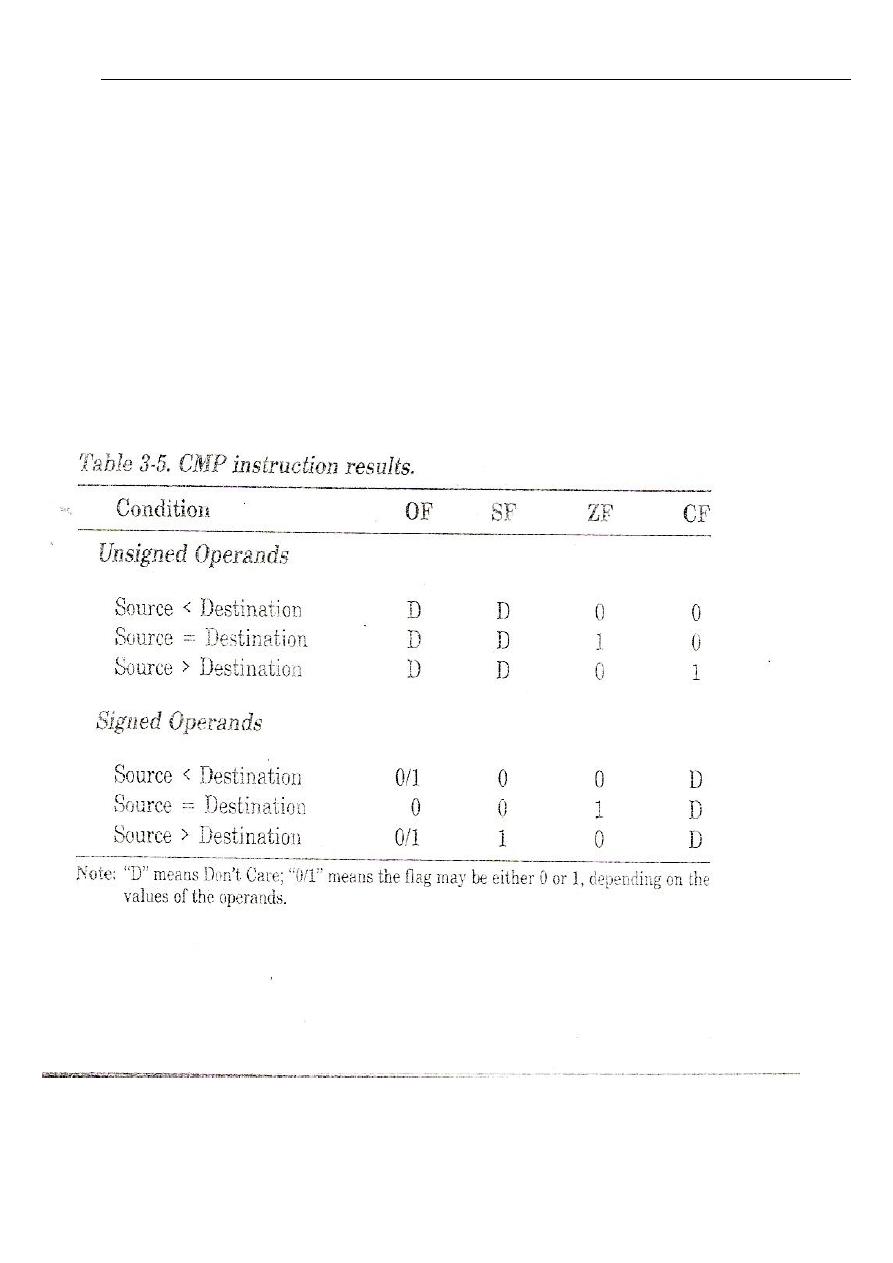
ﺤﺎﺴﺒﺎﺕ ﻤﺘﻘﺩﻤﺔ ﺍﻟﻤﺭﺤﻠﺔ ﺍﻟﺜﺎﻟﺜﺔ ﻫﻨﺩﺴﺔ ﻜﻬﺭﻭ ﻤﻴﻜﺎﻨﻴﻙ ﺍﻟﻤﺩﺭﺱ ﻤﺴﺎﻋﺩ ﺍﻨﻤﺎﺭ ﺨﻠﻴل ﺍﺒﺭﺍﻫﻴﻡ
٨٥
5. Compare Destination to Source (CMP
)
Like the SUB instruction, CMP subtracts a source from a destination and sets or clears
the flags based on the result (see Table 3-5). But unlike SUB, CMP does not save the
result of the subtraction; that is, it doesn't alter the destination. CMP's sale purpose is to
set up the flags for decision-making by conditional jump instructions
اﯾﻌﺎز اﻟﻤﻘﺎرﻧﺔ
CMP
ﯾﺸﺒﮫ اﯾﻌﺎز اﻟﻄﺮح
SUB
ﺑﺎن ﯾﻄﺮح اﻟﻤﺼﺮ ﻣﻦ اﻟﻤﺴﺘﻘﺮ وﯾﻘﻮم ﺑﻮﺿﻊ واﺣﺪ او ﺻﻔﺮ ﻓﻲ
flags
وﺑﺎﻻﻋﺘﻤﺎد ﻋﻠﻰ اﻟﻨﺘﯿﺠﺔ ﻛﻤﺎ ﻓﻲ اﻟﺠﺪول
3-5
وﻟﻜﻦ ﻟﯿﺲ ﻣﺜﻞ،
SUB
ﻓﺎن اﯾﻌﺎز
CMP
ﻻﯾﺨﺰن ﻧﺎﺗﺞ اﻟﻄﺮح وﻻﯾﻐﯿﺮ
اﻟﻤﺴﺘﻘﺮ وھﻮ ﯾﺴﺘﺨﺪم ﻓﻲ ﻋﻤﻠﯿﺔ ﺗﻐﯿﯿﺮ ﻗﯿﻢ
flags
وذﻟﻚ ﻟﺘﺤﺪﯾﺪ ﻗﺮار ﺑﺎﺣﺪ اﯾﻌﺎزات اﻟﻘﻔﺰاﻟﻤﺸﺮوﻃﺔ

ﺤﺎﺴﺒﺎﺕ ﻤﺘﻘﺩﻤﺔ ﺍﻟﻤﺭﺤﻠﺔ ﺍﻟﺜﺎﻟﺜﺔ ﻫﻨﺩﺴﺔ ﻜﻬﺭﻭ ﻤﻴﻜﺎﻨﻴﻙ ﺍﻟﻤﺩﺭﺱ ﻤﺴﺎﻋﺩ ﺍﻨﻤﺎﺭ ﺨﻠﻴل ﺍﺒﺭﺍﻫﻴﻡ
٩٥
Multiplication Instructions
Multiply (MUL) multiplies unsigned numbers and Integer Multiply (IMUL) multiplies
signed numbers. Both can multiply bytes or words
اﯾﻌﺎز اﻟﻀﺮب
MUL
ﯾﻀﺮب ارﻗﺎم ﺑﺪون اﺷﺎرة واﻻرﻗﺎم اﻟﺼﺤﯿﺤﺔ
و
اﻻﯾﻌﺎز
IMUL
ﯾﻀﺮب اﻻرﻗﺎم ﺑﺎﻻﺷﺎرة
وﻛﻼھﻤﺎ ﯾﻀﺮب ارﻗﺎم ﺑﻄﻮل ﺑﺎﯾﺖ او ﻛﻠﻤﺔ
Multiply, Unsigned (MUL) and Integer Multiply, Signed (IMUL)
The 8086 multiply instructions have the general forms
MUL SOURCE
IMUL SOURCE
where source is a byte- or word-length general register or memory location. For the second
operand, MUL and IMUL use the contents of AL (for byte operations) or AX (for word
operations). They return double-length products as follows:
ﻌﺎﺯﻱـﻴﻻﺍ ﻥﺎﻓ ﻲﻨﺎـﺜﻟﺍ لﻤﺎﻌـﻤﻟﺍﻭ ﺓﺭﻜﺍﺫ ﻊـﻗﻭـﻤ ﻭﺍ ﻡﺎـﻋ لـﺠﺴﻤ ﻲﻓ ﺔﻤـﻠﻜ ﻭﺍ ﺕﻴﺎﺒ ﻥﻭﻜﻴ ﺩﻗ ﺭﺩﺼﻤﻟﺍ ﻥﺍ ﺙﻴﺤ
MUL and IMUL
ﺘﺴﺘﺨﺩﻡ ﻤﺤﺘﻭﻯ ﺍﻟﻤﺴﺠل
AL
ﻟﻌﻤﻠﻴﺎﺕ ﺍﻟﺒﺎﻴﺕ ﻭﻤﺴﺠل
AX
ﻟﻌﻤﻠﻴﺎﺕ ﺍﻟﻜﻠﻤﺔ ﻭﺍﻟﻘﻴﻤﺔ ﺍﻟﻨﺎﺘﺠﺔ ﺴﺘﻜﻭﻥ
ﻀﻌﻑ ﻁﻭل ﺍﻻﺭﻗﺎﻡ ﺍﻟﺘﻲ ﺘﻡ ﻀﺭﺒﻬﺎ
:
. Multiplying bytes produces a 16-bit product in AH (high byte) and AL (low byte)
. Multiplying words produces a 32-bit product in DX (high word) and AX (low word)
Upon completion, the Carry and Overflow Flags (CF and OF) tell how much of the
product is relevant. For MUL if the high-order half of the product is zero, CF and OF are
0; otherwise, they are 1. For IMUL, if the high-order half of the product is just a sign-
extension of the low-order half, CF and OF are 0; otherwise, they are 1.
وﺑﺎﻟﻨﺴﺒﺔ ﻟﻞ
flags
ﻓ
ﺎن
CF and OF
ﺗﻜﻮن ﻟﮭﺎ ﻋﻼﻗﺔ ﺑﺎﻟﻨﺎﺗﺞ
.
ﻓﻔﻲ ﺣﺎﻟﺔ اﻟﻀﺮب
MUL
اذاﻛﺎن ﺟﺰء
high-order
ﻣﻦ اﻟﻨﺎﺗﺞ ھﻮ ﺻﻔﺮ ﻓﺎن ﻛﻞ ﻣﻦ
CF and OF
ﺳﺘﻜﻮن ﻗﯿﻤﺘﮭﻤﺎ ﺻﻔﺮ واﻻ ﻓﮭﻲ واﺣﺪ وﻓﻲ ﺣﺎﻟﺔ
IMUL
اذاﻛﺎن ﺟﺰء
high-order
ﻣﻦ اﻟﻨﺎﺗﺞ ھﻮ ﻣﺠﺮد ﺗﻤﺪﯾﺪ ﻟﻼﺷﺎرة ﺻﻔﺮ ﻓﺎن ﻛﻞ ﻣﻦ
CF and OF
ﺳﺘﻜﻮن ﻗﯿﻤﺘﮭﻤﺎ ﺻ
ﻔﺮ واﻻ ﻓﮭﻲ واﺣﺪ

ﺤﺎﺴﺒﺎﺕ ﻤﺘﻘﺩﻤﺔ ﺍﻟﻤﺭﺤﻠﺔ ﺍﻟﺜﺎﻟﺜﺔ ﻫﻨﺩﺴﺔ ﻜﻬﺭﻭ ﻤﻴﻜﺎﻨﻴﻙ ﺍﻟﻤﺩﺭﺱ ﻤﺴﺎﻋﺩ ﺍﻨﻤﺎﺭ ﺨﻠﻴل ﺍﺒﺭﺍﻫﻴﻡ
٠٦
MUL BX ;Unsigned multiply of BX times AX
MUL MEM_BYTE ; Unsigned multiply of memory times AL
IMUL DL ; signed multiply of BL times AL
IMUL MEM_WORD ; signed multiply of memory times AX
Division Instructions
Divide (DIV) performs an unsigned division, while Integer Divide (IDIV) performs a
signed division
ان اﯾﻌﺎز
DIV
ﯾﻘﺪم ﻋﻤﻠﯿﺔ اﻟﻘﺴﻤﺔ ﻻﻋﺪاد ﺑﺪون اﺷﺎرة ﺑﯿﻨﻤﺎ
IDIV
ﯾﻘﺴﻢ ارﻗﺎم ﺑﺎﺷﺎرة
Divide, Unsigned (DIV) and Integer Divide, Signed (IDIV)
DIV SOURCE
IDIV SOURCE
where source is a byte- or word-sized general register or memory location that contains
the divisor (the value by which you want to divide). The dividend is a double-length
operand contained in either AH and AL (for byte operations) or DX and AX (for word
operations).
ﻊ ﺫﺍﻜﺭﺓ ﺍﻟﺘﻲ ﺘﺤﺘﻭﻱ ﻋﻠﻰ ﻗﻴﻡ ﺍﻟﻤﻘﺴﻭﻡ ﻋﻠﻴﻪـﻗﻭـﻤ ﻭﺍ ﻡﺎـﻋ لـﺠﺴﻤ ﻲﻓ ﺔﻤـﻠﻜ ﻭﺍ ﺕﻴﺎﺒ ﻥﻭﻜﻴ ﺩﻗ ﺭﺩﺼﻤﻟﺍ ﻥﺍ ﺙﻴﺤ
ﻭﺍﻟﻤﻘﺴﻭﻡ ﻗﺩ ﻴﻜﻭﻥ ﻓﻲ ﻤﺴﺠل
AH and AL
ﻭﻗﺩ ﻴﻜﻭﻥ ﻓﻲ ﻤﺴﺠﻠﻲ
DX and AX
ﻓﻲ ﺤﺎﻟﺔ ﺍﻟﻜﻠﻤﺎﺕ
DIV and IDIV produce the following results:
. If the source operand is a byte, the quotient is returned in AL and the remainder in AH.
. If the source operand is a word, the quotient is returned in AX and the remainder in DX.

ﺤﺎﺴﺒﺎﺕ ﻤﺘﻘﺩﻤﺔ ﺍﻟﻤﺭﺤﻠﺔ ﺍﻟﺜﺎﻟﺜﺔ ﻫﻨﺩﺴﺔ ﻜﻬﺭﻭ ﻤﻴﻜﺎﻨﻴﻙ ﺍﻟﻤﺩﺭﺱ ﻤﺴﺎﻋﺩ ﺍﻨﻤﺎﺭ ﺨﻠﻴل ﺍﺒﺭﺍﻫﻴﻡ
١٦
Both instructions leave the flags undefined. However, if the quotient cannot fit in the
destination register (AL or AX)-that is, if it overflows the destination the 8086 has a
dramatic way of telling you that the result is invalid: it generates a type 0 (divide by 0)
interrupt.
وﺑﺎﻟﻨﺴﺒﺔ ﻟﻞ
flags
ﻓﺎن اﻻﯾ
ﻌﺎزﯾﻦ ﻻﯾﺆﺛﺮان ﻋﻠﻰ اي
flags
وﻟﻜﻦ ﻓﻲ ﺣﺎﻟﺔ ﻛﻮن ﻧﺎﺗﺞ اﻟﻘﺴﻤﺔ ﻻﯾﻤﻜﻦ ﺧﺰﻧﮫ ﻓﻲ ﻣﺴﺠﻠﻲ
AL or AX
ﻓﺎن ﻋﻤﻠﯿﺔ
overflows
ﺳﻮف ﺗﻔﻌﻞ وﯾﻠﺪ ﻣﻔﺎﻃﻌﺔ اﻟﺘﻘﺴﯿﻢ ﻋﻠﻰ ﺻﻔﺮ
The following conditions cause a divide overflow:
وھﺬه اﻟﺤﺎﻻت ﺗﻮﻟﺪ
divide overflow
1. The divisor is zero.
2. For an unsigned byte divide, the dividend is at least 256 times larger than
the divisor.
3. For an unsigned word divide, the dividend is at least 65,536 times larger
than the divisor.
4. For a signed byte divide, the quotient exceeds + 127 or -128.
5. For a signed word divide, the quotient exceeds + 32,767 or -32,768.
Here are some typical division operations:
DIV BX ;Divide DX:AX By BX, unsigned
DIV MEM_BYTE ; Divide AH:AL By MEMORY, unsigned
IDIV DL ; Divide AH:AL By DL, signed
IDIV MEM_WORD ; Divide DX:AX By MEMORY, signed
